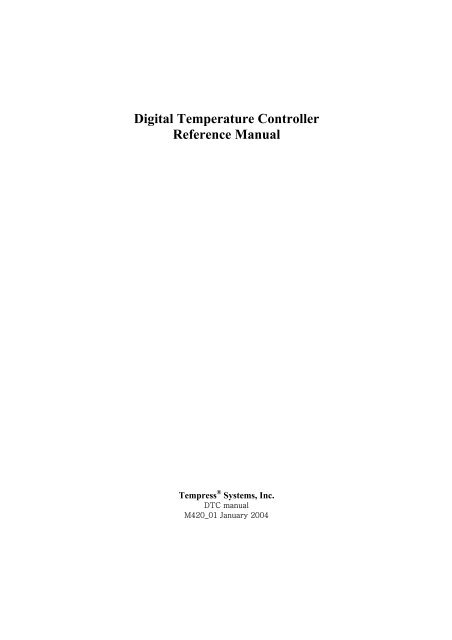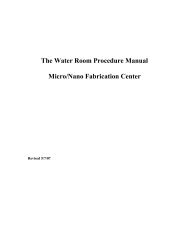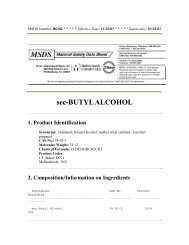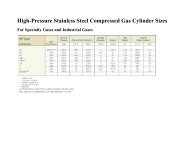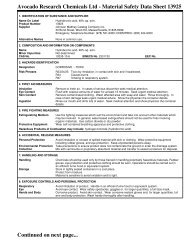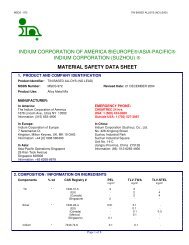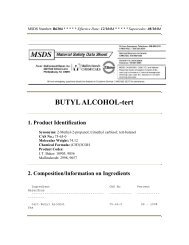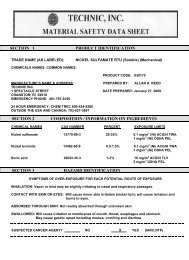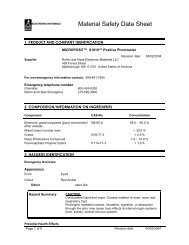Digital Temperature Controller Reference Manual
Digital Temperature Controller Reference Manual
Digital Temperature Controller Reference Manual
You also want an ePaper? Increase the reach of your titles
YUMPU automatically turns print PDFs into web optimized ePapers that Google loves.
<strong>Digital</strong> <strong>Temperature</strong> <strong>Controller</strong><br />
<strong>Reference</strong> <strong>Manual</strong><br />
Tempress ® Systems, Inc.<br />
DTC manual<br />
M420_01 January 2004
This page intentionally left blank
Table of Contents<br />
TABLE OF CONTENTS<br />
1. Introduction .......................................................................1-1<br />
1.1 Scope of the manual.................................................................. 1-1<br />
1.2 Overview.................................................................................... 1-1<br />
1.3 DTC System Features ............................................................... 1-1<br />
1.4 Technical Specifications ............................................................ 1-4<br />
2. Technical Description.......................................................2-1<br />
2.1 Introduction................................................................................ 2-1<br />
2.2 <strong>Controller</strong> unit ............................................................................ 2-1<br />
2.2.1 Pre-amplifier board ....................................................... 2-1<br />
2.2.2 Converter board ............................................................ 2-1<br />
2.2.3 Microprocessor Board................................................... 2-2<br />
2.2.4 Communication board................................................... 2-3<br />
2.2.5 Output board ................................................................. 2-3<br />
2.2.6 Power Supply board...................................................... 2-4<br />
2.3 Hardware <strong>Temperature</strong> Control Loop ........................................ 2-4<br />
2.3.1 Input circuit.................................................................... 2-4<br />
2.3.2 Output circuit................................................................. 2-4<br />
2.4 Software <strong>Temperature</strong> Control Loop.......................................... 2-4<br />
2.4.1 Spike Control ................................................................ 2-5<br />
2.4.2 Paddle control ............................................................... 2-7<br />
3. DTC Configuration ............................................................3-1<br />
3.1 Introduction................................................................................ 3-1<br />
3.2 Diffusion furnaces ...................................................................... 3-1<br />
3.2.1 Furnace with DPC......................................................... 3-1<br />
3.2.2 Stand-alone................................................................... 3-1<br />
3.2.3 Furnace with source furnace, stand-alone .................... 3-1<br />
3.3 Conveyer furnaces..................................................................... 3-3<br />
3.3.1 Small band conveyors................................................... 3-3<br />
3.3.2 Broadband conveyors ................................................... 3-3<br />
DIGITAL TEMPERATURE CONTROLLER REFERENCE MANUAL I
TABLE OF CONTENTS<br />
3.3.3 Recipes......................................................................... 3-4<br />
3.4 Independent or Master/Slave Control ........................................ 3-4<br />
4. Installation and Calibration ..............................................4-1<br />
4.1 Installation ................................................................................. 4-1<br />
4.2 Calibration ................................................................................. 4-1<br />
4.2.1 Equipment required....................................................... 4-1<br />
4.2.2 Analog-to-digital converter board .................................. 4-2<br />
4.2.3 Channel input board with cold junction board ............... 4-3<br />
4.3 Repair ........................................................................................ 4-7<br />
DIGITAL TEMPERATURE CONTROLLER REFERENCE MANUAL II
List of figures<br />
LIST OF FIGURES<br />
Figure 1-1 DTC basic overview ............................................................... 1-1<br />
Figure 2-1 Jumpers position at processor board ..................................... 2-3<br />
Figure 2-2 Ramping comparisons ........................................................... 2-5<br />
Figure 2-3 Software temperature control loop ......................................... 2-6<br />
Figure 3-1 DTC Configurations ............................................................... 3-2<br />
Figure 3-2 Independent and Master/Slave control .................................. 3-4<br />
Figure 4-1 Converter Card and Rear Connector ..................................... 4-2<br />
Figure 4-2 Channel Input Card................................................................ 4-4<br />
DIGITAL TEMPERATURE CONTROLLER REFERENCE MANUAL III
1.Introduction<br />
1.1 Scope of the manual<br />
INTRODUCTION<br />
The <strong>Digital</strong> <strong>Temperature</strong> <strong>Controller</strong> (DTC) forms the heart of the system control together<br />
with the <strong>Digital</strong> Process <strong>Controller</strong> (DPC). This manual contains a technical description of<br />
the DTC for version 2I or higher and is mainly aimed at maintenance and service engineers.<br />
It includes technical information and calibration procedures of the DPC. This manual forms<br />
part of a series of manuals covering the full range of Amtech Tempress Systems products.<br />
The contents of this manual and drawings are to provide the necessary instructions and<br />
information for installing, adjustment, operating, maintenance, and understanding of the<br />
Amtech/Tempress Systems <strong>Digital</strong> Process <strong>Controller</strong>.<br />
1.2 Overview<br />
The <strong>Digital</strong> <strong>Temperature</strong> <strong>Controller</strong> (DTC) is designed for high accuracy control of<br />
temperature for diffusion and conveyor furnaces. Its modular design makes it suitable for the<br />
simplest application and easily expandable for the most complex applications.<br />
The DTC consists of two basic units:<br />
1. The temperature controller Unit<br />
2. Touchscreen Display and/or TSC-II<br />
For Conveyor Furnaces, Output Expander Units are provided to house the necessary extra<br />
output boards.<br />
1.3 DTC System Features<br />
Figure 1-1 DTC basic overview<br />
INDEPENDENT TEMPERATURE<br />
ZONES<br />
MASTER/SLAVE CONTROL<br />
A maximum of 15 temperature zones can be<br />
independently controlled.<br />
It is possible to operate six zones independently or<br />
in a master/slave configuration where one zone is<br />
the master of 4 or 5 other zones.<br />
DIGITAL TEMPERATURE CONTROLLER REFERENCE MANUAL 1-1
HIGH ACCURACY<br />
THERMOCOUPLE CONTROL<br />
FAST COOLDOWN<br />
SOFTWARE TEMPERATURE<br />
CONTROL LOOP<br />
TEMPERATURE RAMPING<br />
AUTOMATIC PROFILING<br />
RECIPE STORAGE<br />
TEMPERATURE ALARM<br />
INTRODUCTION<br />
The DTC's Analog to <strong>Digital</strong> converter gives<br />
temperature resolution to 0.05.<br />
The DTC provides temperature control using spike<br />
thermocouples at the outside of the process tube or<br />
paddle thermocouples inside the tube.<br />
This optional feature provides shorter cooling time<br />
for a higher production capacity.<br />
The temperature control uses a cascading PID loop<br />
of the spike or paddle thermocouple input signals.<br />
Gain control is provided for limiting the maximum<br />
power output.<br />
<strong>Temperature</strong> ramping is provided on all zones. This<br />
guarantees a long flat zone during and ramping up<br />
or down, by making use of calculated values from a<br />
profile table or continuously controlling the<br />
temperature using the paddle thermocouples<br />
Automatic profiling is continuously possible during<br />
the process or by means of specially programmed<br />
recipes.<br />
DTC and DPC versions 2I and higher provide an<br />
unlimited number of temperature setpoints in a<br />
process recipe.<br />
An alarm is generated when the temperature rise<br />
above or fall below programmable limits. The alarm<br />
limits can be in the range 0.1-25.5 oC.<br />
BROKEN THERMOCOUPLE ALARM An alarm is generated when a thermocouple is<br />
broken. In spike control the affected zone is<br />
maintained at approximate temperature by using the<br />
thermocouple break output table measured during<br />
profiling. If the zone is in paddle control and the<br />
thermocouples fails control is switched to the spike<br />
thermocouple.<br />
DIGITAL TEMPERATURE CONTROLLER REFERENCE MANUAL 1-2
POWER FAIL ALARM<br />
CALIBRATION TEMPERATURE<br />
STORAGE<br />
5 TYPES OF THERMOCOUPLES<br />
THERMOCOUPLES INPUTS<br />
SIDE ZONES<br />
MODULAR SYSTEM<br />
ANALOG INPUT (0-5V)<br />
DIGITAL INPUTS<br />
BATTERY BACK-UP<br />
INTRODUCTION<br />
An alarm is generated when the heating element<br />
fails, power is interrupted or the SCR driving unit<br />
fails.<br />
Up to 16 calibration temperatures can be stored.<br />
The DTC supports several types of thermocouples.<br />
These are ptRh 13%, ptRh 10%, Platinel II, Nich-Ni<br />
(Type k) and ptRh 6%.<br />
The controller can contain up to 5 3-channel input<br />
boards. Each board inputs data from 3<br />
thermocouples, which may be any of the above<br />
types.<br />
Each zone can be coupled with 2 side zones (used in<br />
broadband Conveyor Furnaces). The gain of these<br />
zones is independently programmable.<br />
The modular construction of the DTC makes it<br />
easily expandable. This also improves the<br />
serviceability of the units. All boards are accessible<br />
from the front of the controller.<br />
This enables an external analog ramp unit to be<br />
connected. This is only applicable to zones 1, 2 and<br />
3 in a three-zone furnace tube. The 0 to 5V range<br />
correspond to 0 to 1000 oC below controller<br />
setpoint. Used for calibration of the converter board.<br />
These enable the selection of recipes by means of an<br />
external timing unit. (Only if there is no DPC)<br />
An external Ni-Mh battery maintains data stored in<br />
volatile memory for a minimum of 60 days after<br />
power is disconnected<br />
DIGITAL TEMPERATURE CONTROLLER REFERENCE MANUAL 1-3
1.4 Technical Specifications<br />
MAX. NUMBER OF CONTROL<br />
ZONES:<br />
15<br />
SETPOINT RANGES: Type R, PtRh 13 % 0 - 1400.0 oC<br />
SETPOINT RESOLUTION:<br />
Type S, PtRh 10% 0 - 1400.0 oC<br />
Platinel II 0 - 1200.0 oC<br />
Type K, Nichr-Ni 0 - 1200.0 oC<br />
Type B, PtRh 6% 0 - 1400.0 oC<br />
0.1 oC<br />
DISPLAY RANGE: PtRh 6%, 10% and 13% 0 - 1499.9 oC<br />
PROPORTIONAL BAND<br />
RANGE:<br />
INTEGRAL RANGE:<br />
DERIVATIVE RANGE:<br />
% POWER:<br />
PROGRAMMABLE SLOPE<br />
RANGE:<br />
ALARM RANGE HL AND LL:<br />
Type K, Platinel II 0 - 1299.9 oC<br />
1 - 100 oC<br />
0 - 25.5 min.<br />
0-255 s.<br />
0-98%<br />
0-100.00 oC/min.<br />
STANDARD CONDITIONS: 30 days 1 µV.<br />
TEMPERATURE DRIFT: 0.2 µV/ oC max.<br />
SUPPLY VOLTAGE<br />
REJECTION:<br />
OUTPUT SAMPLE RATE:<br />
0.0-25.5 oC (deviation from setpoint)<br />
0.5 µV max. over supply range ( 10%)<br />
1 second<br />
INTRODUCTION<br />
DIGITAL TEMPERATURE CONTROLLER REFERENCE MANUAL 1-4
OPERATING VOLTAGE:<br />
AMBIENT TEMPERATURE:<br />
CONTROL OUTPUT:<br />
ALARM OUTPUT:<br />
RAMP OUTPUT:<br />
ANALOG INPUT:<br />
DIGITAL INPUTS:<br />
115/220/240 (optionally 208V), 50/60 Hz.<br />
0 - 40 oC<br />
INTRODUCTION<br />
Zero voltage crossing optically isolated SCR or Triac<br />
driver. On state RMS current 100mA max.<br />
Relay o/p, contact rating max 240V, 0.5A<br />
TTL Buffered Output. (optionally open collector)<br />
0 - 5V, corresponding to 0 - 1000 oC below setpoint<br />
(zones 1, 2 and 3 only). Used for calibration.<br />
4 TTL inputs for selecting recipe numbers (only for use<br />
without DPC)<br />
DIGITAL TEMPERATURE CONTROLLER REFERENCE MANUAL 1-5
2.Technical Description<br />
2.1 Introduction<br />
TECHNICAL DESCRIPTION<br />
The <strong>Digital</strong> <strong>Temperature</strong> <strong>Controller</strong> has three fundamental components to suit many<br />
applications such as diffusion furnaces and broadband conveyor furnaces. The main<br />
components are:<br />
a) <strong>Controller</strong> Unit<br />
b) Program Unit<br />
c) Output Expander Units<br />
The hardware and software for the <strong>Temperature</strong> Control Loop, the heart of the DTC, is<br />
contained in the <strong>Controller</strong> Unit. The user interface is provided by the Program Unit and the<br />
Output Expander Unit allows up to 15 temperature control zones to be used (in broadband<br />
conveyor furnaces)<br />
2.2 <strong>Controller</strong> unit<br />
The controller unit is the main part of the DTC. This unit is responsible for collecting all the<br />
data from the thermocouples and providing control of the zones in the furnace. All the<br />
boards are connected via a specially designed bus on a motherboard. A technical description<br />
of the boards is given in the following sections:<br />
2.2.1 Pre-amplifier board<br />
The 3-channel preamplifier board is used to lineairize and amplify the mV signal originating<br />
from the thermocouples into a 0-10V signal that can be processed by the processor board.<br />
Five (5) slots are available so a maximum of 15 control zones can be monitored. For a<br />
diffusion furnace the slots 1(&2) are used for the spike thermocouple signals (1 for a 3-zone<br />
furnace, 1&2 for a 5-zone furnace). Slots 5&4 are used for the paddle thermocouple signals<br />
(5 for a 3-zone furnace, 5&4 for a 5-zone furnace).<br />
2.2.2 Converter board<br />
The converter board contains the 16-bit A-D converter, which converts the analog<br />
(amplified) thermocouple signal into a digital signal that can be used by the processor board.<br />
The full description of its operation is given in the description of the Hardware <strong>Temperature</strong><br />
Control Loop.<br />
In the event that no DPC is present (which normally is used to select a temperature recipe)<br />
the converter board is capable of selecting the desired temperature recipe. The converter<br />
board contains 4 inputs for recipe selection, in case there is no connection between the DTC<br />
and DPC. These inputs are connected to the terminals 13-16. These inputs have pull-up<br />
resistors, so that an open input corresponds to a logical 1 input. The digital inputs are active<br />
DIGITAL TEMPERATURE CONTROLLER REFERENCE MANUAL 2-1
TECHNICAL DESCRIPTION<br />
only if the digital select input is connected to the digital 0 during a restart of the program.<br />
The digital inputs are used to select the recipe number. This information is coded in binary as<br />
follows.<br />
Recipe 0<br />
Recipe 1<br />
Recipe 2<br />
Recipe 3<br />
Recipe 4<br />
Recipe 5<br />
Recipe 6<br />
Recipe 7<br />
Recipe 8<br />
Recipe 9<br />
Recipe 10<br />
Recipe 11<br />
Recipe 12<br />
Recipe 13<br />
Recipe 14<br />
Recipe 15<br />
Pin 16 Pin 15 Pin 14 Pin 13<br />
1<br />
1<br />
1<br />
1<br />
1<br />
1<br />
1<br />
1<br />
0<br />
0<br />
0<br />
0<br />
0<br />
0<br />
0<br />
0<br />
1<br />
1<br />
1<br />
1<br />
0<br />
0<br />
0<br />
0<br />
1<br />
1<br />
1<br />
1<br />
0<br />
0<br />
0<br />
0<br />
When the furnace is running profile or normal recipes, the digital inputs can be used to select<br />
the number (0 - 15).<br />
2.2.3 Microprocessor Board<br />
The hub of the system is a Motorola CMOS 8-bit microprocessor. The on-board timer is<br />
used for all the timing functions. This board has one socket housing the functional EPROM<br />
and three sockets for the (8 Kb) memory chips. The processor board is equal for DTC and<br />
DPC, the functional EPROM and the amount of memory chips define the function of the<br />
processor board.<br />
For a DTC processor board a DTC EPROM and 1 memory chip is sufficient (for a DPC<br />
processor board a DPC EPROM and 3 memory chips are required).<br />
DIGITAL TEMPERATURE CONTROLLER REFERENCE MANUAL 2-2<br />
1<br />
1<br />
0<br />
0<br />
1<br />
1<br />
0<br />
0<br />
1<br />
1<br />
0<br />
0<br />
1<br />
1<br />
0<br />
0<br />
1<br />
0<br />
1<br />
0<br />
1<br />
0<br />
1<br />
0<br />
1<br />
0<br />
1<br />
0<br />
1<br />
0<br />
1<br />
0
TECHNICAL DESCRIPTION<br />
Communication between the DTC and Touchscreen goes via the DPC communication<br />
boards.<br />
The processor board is provided with an automatic restart circuit. If the microprocessor<br />
stops for more than 5 seconds, the power supply supervisor will generate a reset signal.<br />
Figure 2-1 Jumpers position at processor board<br />
This board also contains a set of 5 jumpers to select the number of control zones for<br />
diffusion and conveyor furnace and the type of thermocouple. The possible configurations<br />
are shown below:<br />
• Selection of number of control zones<br />
3 diff 5 diff 6 diff 2x3 diff 6 conv 9 conv 12 conv 15 conv<br />
• Selection of Thermocouple type<br />
PtRH 13% PtRH 10% Platinel II Nich-Ni<br />
2.2.4 Communication board<br />
The DTC communication board provides optically isolated serial communication between<br />
DTC and DPC using a RS422 protocol at 9600 baud through a 10-pole connector.<br />
2.2.5 Output board<br />
The DTC output board sends the output signal from the processor board to the SCR<br />
interconnection board. 3 LED’s indicate the output level and should blink at least once per<br />
second.<br />
DIGITAL TEMPERATURE CONTROLLER REFERENCE MANUAL 2-3
2.2.6 Power Supply board<br />
TECHNICAL DESCRIPTION<br />
The power supply board generates the required +12, -12, +5 and -5 V that is required for the<br />
DTC.<br />
2.3 Hardware <strong>Temperature</strong> Control Loop<br />
2.3.1 Input circuit<br />
Preamplifier: The thermocouple signals are amplified on the 3-channel input boards in<br />
separate preamplifiers. The main components of these preamplifiers are a chopper stabilized<br />
operational amplifier, an open loop voltage gain amplifier and a 1 Hz filter and buffer.<br />
The chopper amplifier amplifies the low-level input first. The operational amplifier following<br />
the chopper amplifier increases the open loop voltage gain, to give an accurate and linear<br />
voltage gain over the complete input range. The 1 Hz filter limits the bandwidth of the<br />
preamplifier. This filter and the buffer are switched before the feedback resistor point. This<br />
eliminates errors introduced due to the leakage of the filter capacitors and the offset voltage<br />
of the 741 op-amp.<br />
Each 3-channel input board has one cold junction compensator circuit. The temperature at<br />
the cold junction is measured by a transducer, which produces an output current of 1 µA/K.<br />
This results in an output voltage from the amplifier of 33.9mV/ oC. After passing through a<br />
resistor divider, this becomes the correct cold junction compensation voltage for every<br />
amplifier.<br />
The output voltage of each preamplifier is 0 - 10V, corresponding to an input range of 0 -<br />
1500 oC for a PtRh 13% (type R) thermocouple.<br />
The input impedance is 4 K Ohm and to assure the mV source does not drop in voltage<br />
during measurement it should have an output impedance of 0.1 Ohm.<br />
A-D Conversion: The output voltage from the preamplifier is multiplexed and converted on<br />
the 16-channel A-D converter board. Fifteen channels of the 16 channel multiplexer are used<br />
for a maximum of 15 temperature-input signals, the remaining one being for the analog input<br />
from the rear connector. The channel to be converted is selected by the microprocessor<br />
setting the PA0-PA3 outputs of the PIA (Peripheral Interface Adapter).<br />
2.3.2 Output circuit<br />
A zero voltage crossing, optically isolated driver is used to fire the SCRs or triacs. The RMS<br />
(Root Mean Square) on state current is 100mA.<br />
Each output channel has an open/short circuit failure detector. The detector circuit measures<br />
the voltage across the SCRs or triacs via an optically coupled isolator and is connected to the<br />
common input bus line through an open collector NAND gate. A Power Alarm will be<br />
generated if the detector circuit detects a SCR failure.<br />
2.4 Software <strong>Temperature</strong> Control Loop<br />
The spike control loop on the spike thermocouples is the same for all zones. The control is<br />
proportional, integral and differential (P.I.D) and gain control is provided for limiting the<br />
power to the heating elements.<br />
DIGITAL TEMPERATURE CONTROLLER REFERENCE MANUAL 2-4
TECHNICAL DESCRIPTION<br />
A maximum of six zones can have paddle control on the paddle thermocouples. The control<br />
is differential, integral (D.I) on the paddle, which is cascaded on the spike thermocouple. In<br />
this type of control, there are 6 control blocks with 6 unique parameters. For each parameter,<br />
there are 5 distinct temperature ranges in steps of 300 oC.<br />
A block diagram of the control loop is shown in Figure 2-3.<br />
2.4.1 Spike Control<br />
The inputs for the spike P.I.D. control are the spike thermocouple reading, spike setpoint<br />
and spike P.I.D. parameters. The spike setpoint is calculated from the profile table. If the<br />
setpoint is not given in the table, the value can be obtained by interpolation.<br />
2.4.1.1 Spike derivative block<br />
The derivative control is used to make immediate changes, whenever the thermocouples<br />
readings change. The output of the block is proportional to the slope of the temperature and<br />
the derivative parameter. Hence, an increase in the derivative parameter will increase the<br />
effect of the derivative function.<br />
The input to this block is the thermocouple reading and not, as in most systems, the<br />
deviation between the setpoint and the reading. It is, also, switched off before the P.I. control<br />
blocks. The effect of these two actions on the ramping is shown in Figure 2-2. As can be<br />
seen the overshoot is greatly reduced. The deviation between setpoint and temperature<br />
during ramping is equal to the Derivative Output (DO = slope x parameter).<br />
The inputs to this block are the current spike thermocouple reading and the derivative<br />
parameter in seconds. The spike derivative value is an average of different spike<br />
thermocouple readings taken over a period of time. This gives a slope or trend to the<br />
movement of temperature in units/s.<br />
The spike derivative output is the derivative value multiplied by the spike derivative<br />
parameter in units of degrees. This value added to the setpoint deviation (setpoint reading)<br />
gives the P.D. output. The P.D. output is limited to plus or minus the proportional band<br />
output.<br />
Figure 2-2 Ramping comparisons<br />
DIGITAL TEMPERATURE CONTROLLER REFERENCE MANUAL 2-5
Figure 2-3 Software temperature control loop<br />
TECHNICAL DESCRIPTION<br />
DIGITAL TEMPERATURE CONTROLLER REFERENCE MANUAL 2-6
2.4.1.2 Spike integral block<br />
TECHNICAL DESCRIPTION<br />
The integral control block brings the temperature back to the setpoint. If there is an error,<br />
this block will make long term adjustments to the power. An increase in the integral<br />
parameter will decrease the amount of change in the (current controlling) output.<br />
The inputs to this block are the P.D. output and the Integral parameter. Every second the<br />
P.D output is divided by the Integral parameter value. This is then added to or subtracted<br />
from the integral output, depending on the sign of the input. The maximum value is equal to<br />
the proportional band value and the minimum is zero. This final value is added to the P.D.<br />
output to give the D.I. output.<br />
2.4.1.3 Spike proportional block<br />
The proportional control is used to create a bandwidth around the controlling setpoint. The<br />
proportional parameter will be the bandwidth at which maximum power will be applied.<br />
Proportional control always gives an offset between setpoint and actual temperature. This<br />
offset is needed to apply the power and is dependent on the proportional parameter and the<br />
amount of power needed to maintain the power. If the proportional bandwidth is too small,<br />
oscillation of the control loop can occur.<br />
The inputs to this block are the D.I. output and the proportional parameter (in degrees). The<br />
output is obtained by dividing the D.I. output by the proportional parameter and then<br />
multiplying by 100. This gives a percentage output (P.I.D).<br />
2.4.1.4 Spike gain block<br />
The gain block limits the maximum output power and is used to stop the controller<br />
oscillating. This is of particular importance at low temperatures. The control loop gives the<br />
best response if the power required to maintain the temperature is 35-45% of the maximum<br />
power.<br />
This block converts the percentage P.I.D. output into a scale related to the gain parameter<br />
value. During the ramping up of a zone, the gain parameter extracted from the parameter<br />
table is increased in relation to the slope of the ramp. If the temperature is below setpoint,<br />
the gain value is increased to compensate for the deficiency. The maximum value of the gain<br />
parameter is 98.<br />
2.4.1.5 Main and side zone gain blocks<br />
The main and side zone gain blocks are used for broadband conveyor furnaces. The three<br />
gain blocks translate the gain controlled PI.D output into three gain controlled power<br />
outputs. The input multiplied by the programmed gain value of the control zone divided by<br />
one hundred gives the current power output value. The maximum power value is 98%. The<br />
output is converted to proportioned on-off for the SCR or triac drivers.<br />
2.4.2 Paddle control<br />
The paddle D.I. control is only active if the zone is programmed for control on the paddle<br />
thermocouple and is only of interest in a diffusion furnace. The output of the D.I. control is<br />
used to modify the setpoint for the spike control loop. These modifications will be in<br />
response to the temperature variations inside the tube.<br />
DIGITAL TEMPERATURE CONTROLLER REFERENCE MANUAL 2-7
2.4.2.1 Paddle derivative block<br />
TECHNICAL DESCRIPTION<br />
The derivative block is the same as for the spike thermocouple. The temperature response<br />
inside the tube has a delay compared to the response outside the tube. This control loop will<br />
automatically give the necessary delay to the ramping, when the paddle derivative parameter<br />
value is greater then the spike derivative value.<br />
The inputs to the paddle derivative block are the paddle thermocouple reading and the<br />
paddle derivative parameter (in seconds). The paddle P.D. output is the sum of the derivative<br />
output and the paddle setpoint deviation (setpoint reading). The output is limited to plus or<br />
minus the proportional band value.<br />
2.4.2.2 Paddle integral block<br />
The integral block is used to make slow adjustments to the spike setpoint to bring the paddle<br />
temperature back to the setpoint. An increase in the paddle integral parameter will decrease<br />
the amount of change in the current spike setpoint. To prevent oscillation, the setpoint<br />
change per second must not exceed the maximum cooling or heating rate of the control<br />
zone. The feedback from the spike P.D. output results in no correction, if the deviation on<br />
the spike and paddle are equal in the same direction or when the deviation on both is out of<br />
the proportional band.<br />
The inputs to this block are the difference between the P.D. outputs of the paddle and spike<br />
blocks and the paddle integral parameter (in 0.1 minutes). The feedback from the P.D. output<br />
of the spike is used to dampen the cascaded control. The paddle integral output is limited to<br />
200 oC. The D.I. output is added to the spike setpoint calculated from the profile table,<br />
which gives the new setpoint for the spike control.<br />
DIGITAL TEMPERATURE CONTROLLER REFERENCE MANUAL 2-8
3.DTC Configuration<br />
3.1 Introduction<br />
DTC CONFIGURATION<br />
The units that can be combined to give the desired configuration are shown in Figure 3-1. All<br />
systems have to contain the <strong>Controller</strong> Unit and the Touch Screen Display.<br />
3.2 Diffusion furnaces<br />
All Diffusion Furnaces require a data input unit (Touchscreen or TSC-II). The <strong>Controller</strong><br />
Unit is also required, but it must be configured according to the type of furnace to be<br />
controlled. This dependents on the number of input and outputs required.<br />
3.2.1 Furnace with DPC<br />
The DTC <strong>Controller</strong> Unit is configured with two or four input boards and one or two output<br />
boards, giving control of up to 6 zones. Automatic Profiling and paddle control is possible if<br />
one (or two) of the input boards is placed in position E (and D).<br />
Communication to the DPC is provided by the communication board. It allows reception of<br />
temperature recipe selections from the DPC and provides temperature information to the<br />
DPC.<br />
The temperature can be ramped in each zone, either independently or under master/slave<br />
control (see section 3.4).<br />
3.2.2 Stand-alone<br />
The DTC <strong>Controller</strong> Unit is configured with two or four input boards and one or two output<br />
boards, depending on the tube configuration (3, 5 or 6 zones). For Automatic Profiling or<br />
control on the paddle thermocouples, a board has to be placed in position ‘E’ (Figure 3-1<br />
DTC Configurations) for the first 3 zones and position ‘D’ for the zones 4, 5 and 6. Boards<br />
for the spike are in position ‘A’ for the first three zones and ‘B’ for the next.<br />
In this configuration, the DTC controls the temperature in all zones of the furnace tube. The<br />
temperature can be ramped in each zone, either independently or under master/slave control<br />
(see section 3.4). The unit can store and run a maximum of 16 recipes.<br />
3.2.3 Furnace with source furnace, stand-alone<br />
The DTC <strong>Controller</strong> Unit is configured with three input boards and two output boards,<br />
giving control of 6 zones (3 in the main furnace and 3 in the source furnace). Automatic<br />
Profiling and paddle control is possible if one of the input boards is placed in position E.<br />
All the zones may be automatically profiled or paddle controlled. The temperature can be<br />
ramped in each zone of the main furnace and source furnace, either independently or under<br />
master/slave control (see section 3.4).<br />
DIGITAL TEMPERATURE CONTROLLER REFERENCE MANUAL 3-1
Figure 3-1 DTC Configurations<br />
DTC CONFIGURATION<br />
DIGITAL TEMPERATURE CONTROLLER REFERENCE MANUAL 3-2
3.3 Conveyer furnaces<br />
DTC CONFIGURATION<br />
All Conveyor Furnaces require the <strong>Controller</strong> Unit and either the Program and Display Unit<br />
or the Touch Screen Display . The difference in configuration depends on the heated length<br />
(number of control zones) and the width of the zones (whether or not side zone control is<br />
used). This will not only affect the number of boards in the <strong>Controller</strong> Unit, but also the type<br />
of Output Expander Unit used and the number of boards therein. If zones 13, 14 and 15 are<br />
not used as control zones, they can be used for profiling or temperature measurement.<br />
3.3.1 Small band conveyors<br />
The system configuration is solely dependent on the number of control zones used:<br />
a) For 1 to 6 Control Zones<br />
The system will consist of the <strong>Controller</strong> Unit and the Program and Display Unit or<br />
the Touch Screen Display , containing one or two, 3 channel input boards and one<br />
or two, 3 channel output boards. The number of input boards will be the same as<br />
the number of output boards.<br />
For example: To control 2 zones, one input board and one output board is necessary.<br />
b) For more than 6 Control Zones<br />
Besides the <strong>Controller</strong> Unit fitted with an Output Expander Interconnection board<br />
and the Program and Display Unit or the Touch Screen Display. An Output<br />
Expander Unit A has to be added to the configuration. The <strong>Controller</strong> Unit will<br />
contain the appropriate number of input boards (1 board for every 3 control zones)<br />
and an Output Expander Interconnection board placed in the first output board slot.<br />
The Output Expander Unit A will contain between 3 and 5 output boards depending<br />
on the number of control zones. There must be the same number of input and<br />
output boards.<br />
3.3.2 Broadband conveyors<br />
For the broadband conveyors or small band conveyors with accurate crossbelt temperature<br />
control, gain control on the two side zones is needed. The system requires the <strong>Controller</strong><br />
Unit fitted with an Output Expander Interconnection board and either the Program and<br />
Display Unit or the Touch Screen Display;, and the Output Expander Unit B. The<br />
differences in configuration stem from the number of control zones used.<br />
a) For 1 to 9 Control Zones<br />
The <strong>Controller</strong> Unit is fitted with one to three input boards (1 board for every 3<br />
control zones). Output Expander Unit B contains an output board for each zone,<br />
which triggers the main zone and it's 2 side zones.<br />
b) For more than 9 Zones<br />
The <strong>Controller</strong> Unit is fitted with four or five input boards (1 board for every 3<br />
control zones). Output Expander Unit B contains the maximum nine output boards.<br />
It is, therefore, necessary that Output Expander Unit C is used, containing one<br />
board for each zone greater than nine.<br />
DIGITAL TEMPERATURE CONTROLLER REFERENCE MANUAL 3-3
3.3.3 Recipes<br />
DTC CONFIGURATION<br />
As of DTC version 2.I an unlimited amount of temperature recipes can be stored. Older<br />
DTC’s can store a maximum of 16 recipes. The recipes can be selected manually with the<br />
Touch Screen or TSC-II or automatically via the DPC or by using the digital inputs on the<br />
rear connector if no DPC is present.<br />
All the zones include ramping as part of the recipes, thus ensuring the temperature rises at a<br />
controlled rate. This prevents furnace, tube or muffle damage due temperature shock. An<br />
external timer can switch the DTC from one recipe to another. This can be used as an energy<br />
saving feature that allows the temperature of the furnace to be lowered at nights and<br />
weekends.<br />
3.4 Independent or Master/Slave Control<br />
The control zones normally operate in the Independent (I) mode. In this case, all the zones<br />
are completely independent of each other. However, the possibility exists to operate four or<br />
five zones (Slaves) under the control of another (Master). This is known as Master/Slave<br />
Control (MS). In this configuration the center zone (2 in a 3-zone furnace, 3 in a 5-zone<br />
furnace) is the master.<br />
All other zones operate normally as if they were independent zones. However, if during a<br />
ramp up or a cool down the master cannot follow its temperature setpoints, the Master/Slave<br />
loop becomes active. The deviation of the master from its setpoints is subtracted from the<br />
temperature setpoints of the slaves. This results in the same actual temperature for all three<br />
zones.<br />
When the furnace is not ramping, the Master/Slave loop becomes active if the deviation<br />
from the setpoints in the master is greater than 5 ºC.<br />
This configuration will only work correctly if the master is slower than the slaves. If this is<br />
not the case, either the gain value of the slaves has to be increased or the gain value of the<br />
master has to be decreased.<br />
A comparison of the zone temperatures for both types of control is given in Figure 3-2.<br />
Figure 3-2 Independent and Master/Slave control<br />
DIGITAL TEMPERATURE CONTROLLER REFERENCE MANUAL 3-4
4.Installation and Calibration<br />
4.1 Installation<br />
INSTALLATION AND CALIBRATION<br />
STEP 1:<br />
The <strong>Digital</strong> <strong>Temperature</strong> <strong>Controller</strong>, once configured correctly, is mounted on the side of the<br />
furnace. The DTC is installed prior to delivery. Before applying the line voltage to the unit<br />
check if:<br />
a) The local line voltage meets the specified conditions for your particular controller.<br />
b) The SCRs or triacs are wired to the interconnection board SCR stand.<br />
<br />
NOTE<br />
Wiring the SCRs incorrectly could cause serious damage to the DTC<br />
output board.<br />
c) The jumpers on the processor board are set correctly for the number of control<br />
zones and type of thermocouple being used (see section 2.2.3).<br />
STEP 2:<br />
After the above checks are made, the line voltage can be applied to the controller.<br />
Before programming the controller the user should wait 10 seconds, during which time any<br />
alarms generated by the control zones will be displayed.<br />
The unit should now be calibrated as described in the next section.<br />
4.2 Calibration<br />
At the time of delivery, the DTC has been calibrated for accurate operation. However, it is<br />
advisable to repeat the cold junction board calibration of section 4.2.3. To ensure the<br />
continued accuracy of the controller the entire calibration procedure should be carried out at<br />
regular intervals indicated in the maintenance schedule.<br />
4.2.1 Equipment required<br />
The following standard laboratory equipment is required to calibrate the controller.<br />
a) 5 Digit DC <strong>Digital</strong> Voltmeter.<br />
b) Precision Power supply - Resolution 1 µV<br />
c) Ambient <strong>Temperature</strong> Thermometer.<br />
DIGITAL TEMPERATURE CONTROLLER REFERENCE MANUAL 4-1
4.2.2 Analog-to-digital converter board<br />
INSTALLATION AND CALIBRATION<br />
The Analog to <strong>Digital</strong> Converter board is calibrated using the analog input on the rear<br />
connector of the <strong>Controller</strong> Unit (see Figure 4-1).<br />
Figure 4-1 Converter Card and Rear Connector<br />
DIGITAL TEMPERATURE CONTROLLER REFERENCE MANUAL 4-2
STEP 1:<br />
INSTALLATION AND CALIBRATION<br />
If the analog input (pin 18 of the rear connector) is in use, disconnect the wiring. If it is not<br />
in use, connect the analog select input (pin 9) to digital 0 (pin 11). Switch off the line voltage<br />
momentarily to make the analog input active.<br />
STEP 2:<br />
Short the analog select input (pin 18) to the analog 0 (pin 17).<br />
STEP 3:<br />
Program into zone A2 a temperature setpoint of 1100.0 oC. See DTC operating manual or<br />
Touch Screen Display manual for programming instructions.<br />
STEP 4:<br />
Select Display of the paddle setpoint for zone A2.<br />
STEP 5:<br />
Place the probes of the <strong>Digital</strong> Voltmeter on the test points tp 1 and tp 2 of the board and<br />
adjust R13 to give a reference voltage of 10.00V.<br />
STEP 6:<br />
Turn R12 (zero adjust) clockwise until the setpoint reading starts to decrease. Then turn R12<br />
slowly counter-clockwise until the setpoint reading is 1100.0 oC.<br />
STEP 7:<br />
Remove the short circuit on the analog input and apply an input voltage of 5.000V to the<br />
analog input (pin 18) with respect to analog 0 (pin 17). Adjust R11 (gain adjust) to give a<br />
setpoint reading of 100.0 °C and repeat step 5.<br />
STEP 8:<br />
If the analog input is used, reconnect the analog input to the system. If the analog input is<br />
not used, disconnect the short between the analog select input (pin 9) and digital 0 (pin 11)<br />
and turn off the line voltage momentarily to make the analog input inactive.<br />
4.2.3 Channel input board with cold junction board<br />
The calibration of this board should not be attempted until the user is certain that the Analog<br />
to <strong>Digital</strong> Converter board is correctly calibrated. See Figure 4-2 for the position of the<br />
potentiometers.<br />
STEP 1:<br />
Display the three actual temperatures of the input board.<br />
STEP 2:<br />
On the Cold Junction Board short the inputs to the three thermocouple inputs.<br />
STEP 3:<br />
Adjust R26 (R25, R24 (zero adjust)) of the preamplifiers until they all show the same reading<br />
on the display.<br />
DIGITAL TEMPERATURE CONTROLLER REFERENCE MANUAL 4-3
Figure 4-2 Channel Input Card<br />
STEP 4:<br />
INSTALLATION AND CALIBRATION<br />
Measure the ambient temperature around the point at which the thermocouple inputs are<br />
shorted. Adjust R23 so that the displayed reading is equal to the measured ambient<br />
temperature.<br />
STEP 5:<br />
Apply an input voltage to thermocouple input 1 corresponding to 1300 oC for a PtRh 6%,<br />
10% and 13% thermocouple or 1100 oC for a Platinel II or type K thermocouple. For type B<br />
an exception has to made. Because of the less voltage under 400 0C, the adjustment for 0 can<br />
not be done by ambient temperature, but needs to be done by 400 0C.<br />
DIGITAL TEMPERATURE CONTROLLER REFERENCE MANUAL 4-4
NOTE<br />
INSTALLATION AND CALIBRATION<br />
Make sure any reference to calibrated paddle thermocouples has been<br />
removed from the DTC configuration. Failure to do so will results in false<br />
adjustments and incorrect calibration.<br />
The required input voltage dependents on the type of thermocouple and the ambient<br />
temperature around the point at which the input voltage is connected. The input voltage in<br />
the following table gives the millivolts at calibration temperatures at different ambient<br />
temperatures:<br />
Ambient <strong>Temperature</strong><br />
Millivolt at calibration temperature at different ambient<br />
temperartures<br />
1100.000 1300.000 1300.000 1300.000 400.000 1100.000<br />
K R S B B PT2<br />
0 45.119 14.629 13.159 7.848 0.787 45.354<br />
18 44.401 14.529 13.058 7.851 0.790<br />
19 44.361 14.524 13.052 7.851 0.790<br />
20 44.321 14.518 13.046 7.851 0.790<br />
21 44.281 14.512 13.040 7.851 0.790<br />
22 44.240 14.506 13.034 7.851 0.790<br />
23 44.200 14.500 13.028 7.851 0.790<br />
24 44.159 14.494 13.022 7.851 0.790<br />
25 44.119 14.488 13.016 7.850 0.789<br />
The ambient temperature value can be obtained from standard tables. In the following table<br />
the millivolt at different ambient temperatures are given. These are used to calculate the<br />
millivolts at calibration temperature in the previous table.<br />
Ambient <strong>Temperature</strong><br />
Millivolt at different ambient temperatures<br />
K R S B PT2<br />
0 0 0.000 0.000 0.000<br />
18 0.718 0.100 0.101 -0.003<br />
19 0.758 0.105 0.107 -0.003<br />
20 0.798 0.111 0.113 -0.003<br />
21 0.838 0.117 0.119 -0.003<br />
22 0.879 0.123 0.125 -0.003<br />
23 0.919 0.129 0.131 -0.003<br />
24 0.960 0.135 0.137 -0.003<br />
25 1.000 0.141 0.143 -0.002<br />
DIGITAL TEMPERATURE CONTROLLER REFERENCE MANUAL 4-5
STEP 6:<br />
INSTALLATION AND CALIBRATION<br />
Adjust R22 (R21, R20) to give a reading of 1300.0 oC for PtRh 6%,13% and 10% and<br />
1100.0 oC for Platinel II and type K.<br />
STEP 7:<br />
Repeat steps 5 and 6 for zone 2 and 3, adjusting R21 and R20, respectively, in step 6.<br />
<br />
NOTE<br />
Steps 1 to 4 of the above mentioned calibration procedure should be<br />
repeated for every cold junction board present.<br />
DIGITAL TEMPERATURE CONTROLLER REFERENCE MANUAL 4-6
4.3 Repair<br />
INSTALLATION AND CALIBRATION<br />
Qualified personnel only should carry out repair. If the necessary qualified personnel are not<br />
available, the defective controller or module may be returned to the field service office of<br />
Amtech/Tempress Systems.<br />
It is recommended that spare boards and/or modules are kept in stock so a faulty board can<br />
be quickly replaced. This will give the shortest possible down time. The faulty board can then<br />
be repaired offsite.<br />
Most parts are widely available and should be obtainable from local suppliers. However, it is<br />
important that replacement parts comply with the value, tolerance, rating and dimensions<br />
specifications given in the parts list.<br />
Prior to soldering on any printed circuit board make sure that all power to that board is<br />
disconnected. After soldering, the board should be thoroughly cleaned with particular<br />
attention being given to the removal of fluxes and chemical residues.<br />
Repairs to the Cold Junction board or preamplifiers on the input board should be done with<br />
great care, maintaining the original conditions as close as possible.<br />
After a repair to the analog circuitry, the instrument should be re-calibrated.<br />
DIGITAL TEMPERATURE CONTROLLER REFERENCE MANUAL 4-7
INSTALLATION AND CALIBRATION<br />
DIGITAL TEMPERATURE CONTROLLER REFERENCE MANUAL 4-1


